




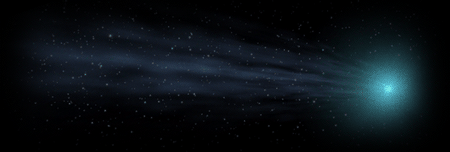




Small asteroids like Ida (above) have insufficient gravity to draw them down into spherical shapes. (1.6.x)
 Some asteroids like Ida and 1999 KW4 (above) have their own moons!
Some asteroids like Ida and 1999 KW4 (above) have their own moons!
![]()
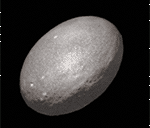
The "dwarf planet" Haumea is one of the fastest rotating objects in the Solar System! It spins on its axis once every four hours! (1.6.x)
In CELESTIA you can view Pluto, Charon,
Hydra and Nix orbiting
their own system's barycenter! (1.6.x)
Note: after running a link like the one above at top for the asteroid Ida, Right Drag with your mouse to get a sense of the 3-dimensional aspects of its structure and orbit.
Are you unfamiliar with our 1.6.x and 1.4.1 links? For an explanation click here.
SURFACE AND CLOSE-UP VIEWS
Humankind's exploration of our Solar System's smaller worlds is still in its infancy. So few spacecraft have yet sent back close-up pictures. Here are links to artists' depictions of varied worlds we may explore in the near future and beyond.
Exploring an Asteroid Close-up ![]()
Astronaut at Asteroid's Surface
Conjectural Close-up of Spacecraft at Comet ![]()
CELES-TIPS
The following will help you enjoy this page's 1.6.x and 1.4.1 links that run events directly in CELESTIA. If you're new to the program, these tips will also help you learn to use it.
You'll find more information about many of CELESTIA's controls on our Learning Center page.
Most of the
"classical asteroids"
orbit the Sun in a vast
doughnut-shaped region
that lies roughly between the orbit of Mars . . .
![]()
. . . and the orbit of
mighty Jupiter!
At roughly the orbit of Jupiter, the Sun warms the volatiles in comets enough to vaporize and begin to form separate gas & dust tails. These angle—and often arc— away from the Sun! ![]()
The Centaurs,
objects similar to the Asteroids, are found between between the orbit of Jupiter . . .
. . . and the orbit of
distant Neptune!
Beyond this lie
countless comets,
asteroid-like objects
and dwarf planets in a
truly immense region of
space that may stretch
well into the Oort Cloud!
Pluto and Charon are
no longer considered to
represent the outer edge of the Solar System.

Dwarf Planet Haumea orbits far beyond
Neptune and Pluto!
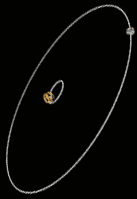
DEMOTED PLUTO
Here we see the
most famous of the dwarf planets and
its largest moon,
Charon, orbiting
their own system's
barycenter.
SMALLER WORLDS
DWARF PLANETS, ASTEROIDS, COMETS,
CENTAURS, KUIPER BELT OBJECTS
AND TRANS-NEPTUNIAN OBJECTS
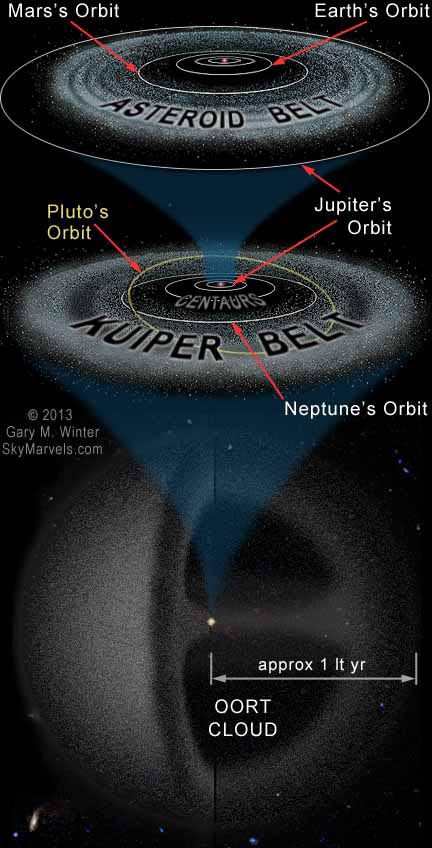
The Sky-Live is an awesome site that lets you examine the orbits and properties of the Solar System's major and smaller worlds. Click on "Pick Object" at upper-left of its window, then choose an object at bottom.
3D Asteroid Catalogue reveals the irregular shapes of various of the Solar System's smaller worlds, many with more than one model. For example, try Asteroid (25143) Itokawa; click on "200k poly" and then on "Grayscale". And NASA's The Usual Suspects is a brief introduction to the Solar System's smaller worlds.
Comets vs. Asteroids is a PDF "Fact Sheet" that you can save or open. It introduces some of the smaller worlds of our Solar System. Comet, Meteor or Meteor- ite? adds more comparisons, and you can download a high-resolution poster. ![]()
DWARF PLANETS
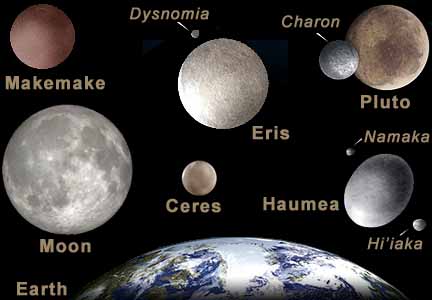
© SkyMarvels, enhancement of NASA, STScI image
A dwarf planet is a body 1.) in orbit directly around the Sun, 2.) with enough mass so its gravity draws it into a roughly spherical shape, and 3.) whose gravity has not cleared the "neighborhood" around its orbit. The five bodies now designated dwarf planets (Pluto, Eris, Make- make, Haumea and Ceres) are shown above compared to Earth and our Moon. Ceres (1.6.x) orbits in the Asteroid Belt, while the other four (1.6.x) (with their primary moons labeled in italics above) orbit in the Kuiper Belt.
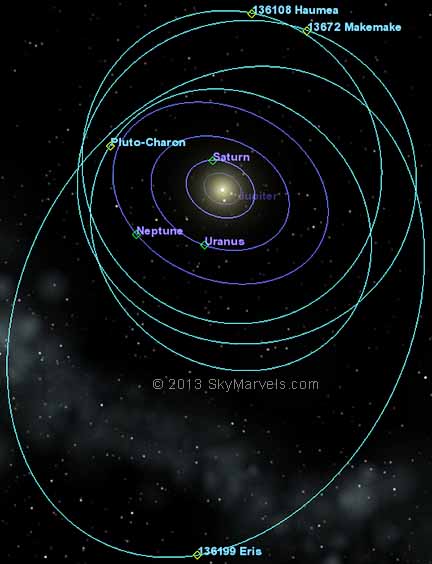
Some astronomers speculate that the total number of dwarf planets may be in the thousands. In fact, some maintain that certain already-discovered larger Kuiper Belt & Trans-Neptunian Objects (KBO's and TNO's) like Sedna and Orcus should be classified as dwarf planets.
On 2015 July 14, after a flight of 9 years and 3 billion miles, NASA's NEW HORIZONS spacecraft ![]() made its closest approach to dwarf planet Pluto, that mysterious body at one time thought to constitute the outer reaches of the Solar System. Where is NEW HORIZONS now? And check out how it passed the Moon and then the other planets. Trajectory More pages: Wikipedia
made its closest approach to dwarf planet Pluto, that mysterious body at one time thought to constitute the outer reaches of the Solar System. Where is NEW HORIZONS now? And check out how it passed the Moon and then the other planets. Trajectory More pages: Wikipedia
Pluto:
View in 3-D
![]() 3-D in Orbit NASA's Overview
3-D in Orbit NASA's Overview
Current Distance and Apparent Size from Earth
Current Location in the Constellations
JPL-NASA Photojournal Wikipedia's page
In True Color ![]() Annotated Map
Annotated Map ![]() Structure
Structure
Atmosphere Compared to Earth's ![]() Orbit in 3-D
Orbit in 3-D
 NEW HORIZONS: Website Flyby
NEW HORIZONS: Website Flyby
Spacecraft in 3-D: #1 ![]() #2
#2
Cool Paper Models: #1 #2
Design Diagrams
Another 3-D Pluto Feature
Pluto Revealed from the LA Times
Moons of Pluto ![]() Wikipedia page
Charon:
Wikipedia page
Charon:
View in 3-D
![]() 3-D in Orbit NASA's Overview
3-D in Orbit NASA's Overview
JPL-NASA Photojournal
Wikipedia's page
Annotated Map ![]() Structure
Structure
Make a Model of the Pluto/Charon System
Ceres:
View in 3-D ![]() 3-D in Orbit NASA's Overview
3-D in Orbit NASA's Overview
Ceres Tool in 3-D
JPL-NASA Photojournal Wikipedia's page
Annotated Map ![]() Ceres Trek Orbit in 3-D
Ceres Trek Orbit in 3-D
Structure Flight Over Ceres
Haumea:
View in 3-D ![]() 3-D in Orbit NASA's In Depth
3-D in Orbit NASA's In Depth
Wikipedia's page Orbit in 3-D
Makemake:
View in 3-D ![]() 3-D in Orbit NASA's In Depth
3-D in Orbit NASA's In Depth
Wikipedia's page Orbit in 3-D
Eris:
View in 3-D ![]() 3-D in Orbit NASA's In Depth
3-D in Orbit NASA's In Depth
Wikipedia's page Orbit in 3-D
Courtesy of: Ian Webster and Asterank.com
Asteroids are rocky objects which orbit the Sun but are too small to be classified as planets. These form the Asteroid Belt, actually more of a donut-shaped region, lying mainly between the orbits of Mars and Jupiter.
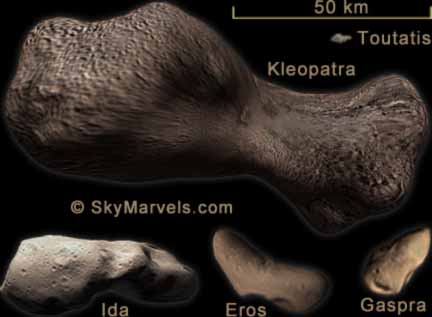
Most asteroids are thought to be fragments "left over" from the formation of our Solar System! Although they range in size from minor worlds hundreds of kilometers in diameter to chunks smaller than an office building, most are small and irregularly shaped.
NASA's Eyes on Asteroids is a cool 3D interactive tool that shows how irregular the shapes of asteroids can be! Check these out! Bennu Eros Geographos Go- levka Itokawa Mithra Psyche Toutatis 1996hw1 Awesome! In additiob, the 3D Asteroid Catalogue gives you access to loads of asteroids, com- ets, dwarf planets and more!
Larger asteroids are relatively rare, but more than 150 are nonetheless large enough to have companion moons! Already over 500,000 asteroids have been identified, though millions more are suspected to exist!
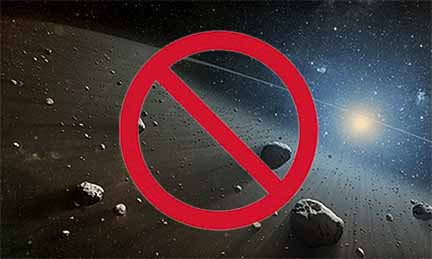
© SkyMarvels, enhancement of NASA, JPL Caltech image
Immediately above, we see how a view from within the Asteroid Belt is most often depicted, like a continuous cloud of rubble with numerous asteroids very near and visible to each other. However, this is a misconception about the belt. In reality, space is incredibly empty. So, despite their great numbers, asteroids on average are separated by such great distances that spacecraft have had no problem flying through the Asteroid Belt. It is estimated that, on average, even very tiny asteroids are separated by tens of thousands of kilometers, while those of appreciable size are separated by 1 to 3 million kilometers!
Asteroids are generally classified into three main types. C-type (carbonaceous) asteroids are the most common, are dark in appearance and are probably made up of of silicate rocks and clay. These are thought to be among the most ancient objects in our Solar System. S-type (silicaceous) asteroids are generally composed of silicates and nickel-iron, and are thus often called the "stony" asteroids. M-type (metallic) asteroids are made up largely of nickel-iron.
Many astronomers surmise that the asteroids represent the material of a planet which never formed, due to the interference of Jupiter's gravity. Even so, the combined mass of all asteroids found in the Asteroid Belt is but a small fraction of the mass of our Moon!
Asterank, which kindly provided the awesome Asteroid Belt animation above, is a 3-D interactive site that beautifully depicts the swarms of asteroids circling the Sun and lets you examine them! Don't forget to check out its Home (Asteroid Data) Page.
Also from the creators of Asterank, Space Reference is another awesome 3-D interactive which lets you view the particulars of over 800,00 celestial objects! But you can add more! View objects alone or with others. Speed up time or slow it down! View Object Classifications like Near Earth Asteroids or an impressive sampling of Categories like Centaur-class Asteroids. To get you started, here are the The First 10 Asteroids Discovered.
Vesta:
Largest asteroid of the Asteroid Belt Vesta Trek
View in 3-D: #1 ![]() #2 Rotating
#2 Rotating
JPL-NASA Photojournal Wikipedia's page
Compared to:
Ceres, Eros, Pluto, Charon Other Asteroids
Touring the Giant Asteroid Vesta (maps)
Hi-Res Annotated Elliptical Map
Structure
NEAR-EARTH ASTEROIDS (NEA's)
A subset of Near-Earth Objects (NEO's), which include both asteroids and comets, near-Earth asteroids are ones whose orbits bring them into proximity of Earth's orbit. As of October 2016, the Catalog of Near-Earth Asteroids had identified over 15,000 objects, over 1,400 having been designated potentially hazardous asteroids (PHA's). NEA's are classified according to their orbits as shown below:

Types of NEA's and Their Percentages:
Apollo: 62% of all NEA's
Aten: 6% of all NEA's
Amor: 32% of all NEA's
IEO: 6 known objects
Due to findings of NASA's Wide-field Infrared Survey Explorer (or WISE) spacecraft, estimates of the number of Near-Earth Asteroids have been revised downward. This video from NASA's Photojournal pages shows why. Changing Views of Our Solar System ![]() And here is an interesting chart that summarizes Near-Earth Asteroid Discovery Statistics
And here is an interesting chart that summarizes Near-Earth Asteroid Discovery Statistics
All this shows that the inner Solar System is a very busy place. Moreover, recent evidence reveals that the Moon is still bombarded far more than was once believed. And therefore, so is Earth!
From NASA's excellent new CNEOS Near-Earth Object site, here are links to its Latest NEO News, NEO Close Aproaches and Fireball & Bolide Map pages.
From NASA/JPL here are animations that show Asteroid 1950 DA's Predicted Close Encounter with Earth in 2880
![]() and what has been called Asteroid 2002 AA29's "Cat & Mouse" Orbit
and what has been called Asteroid 2002 AA29's "Cat & Mouse" Orbit
TROJANS & HILDAS
Trojans ![]() and Hildas
and Hildas ![]() are two families of asteroids classified according to the dynamics of their orbits.
are two families of asteroids classified according to the dynamics of their orbits.
Trojans asteroids share an orbit with a larger body and cluster near its L4 and L5 Lagrange points. Therefore they orbit the Sun about 60° ahead of and behind their parent planet or moon. Typically those near L4 (ahead) are called "Greeks", while those near L5 (behind) are called "Trojans". Nonetheless all are trojan asteroids in the more general sense. Jupiter's trojans are the most famous, numbering in excess of five thousand known objects, though Mars is also known to have trojans.
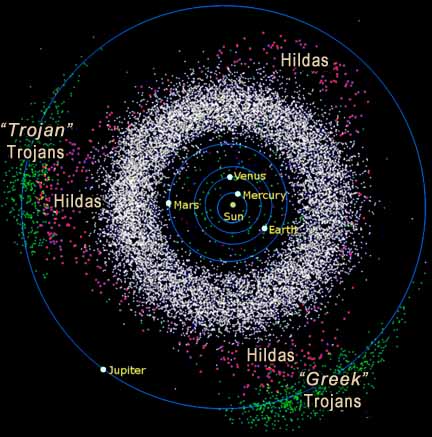
© SkyMarvels, enhancement of NASA image
The intriguing Hildas (or Hildian asteroids) all orbit the Sun in stable 3:2 resonances with Jupiter. This means that the family's individual asteroids each orbit the Sun three times in the same period that Jupiter orbits twice. Nevertheless, as a whole, the Hildas continually appear to cluster into a convex-sided equilateral triangle, with their greatest numbers always found at this triangle's vertices. As these vertices are opposite Jupiter and at the L4 and L5 Lagrange points, the giant triangle thus rotates, synchronized to Jupiter's orbit around the Sun! Over 1,100 Hildas are known to exist.
Motions of Jupiter and the Trojans
Motions of Jupiter, the Trojans & the Hildas
The LUCY Mission will visit both branches of the Tro- jans. (Wikipedia page) Here is an awesome page highlighting LUCY'S Trajectory and shows the 3-D aspects of Jupiter's two Trojan "swarms".
MORE INTERESTING ASTEROID LINKS
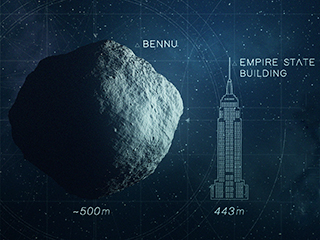 Bennu:
Bennu:
In 3-D: #1 #2
![]() 3-D in Orbit
3-D in Orbit
Map
![]() N Pole Flyover
N Pole Flyover
![]()
OSIRIS-REx Orbits OSIRIS-REx in 3-D
![]()
OSIRIS-REx Mission pages
Rotations: #1
![]() #2
#2
![]()
More asteroids in 3-D:
Itokawa
![]() Eros
Eros
![]() Churyumov-Gerasimenko
Churyumov-Gerasimenko
Ryugu
From JPL: All Known Asteroids 1999 - 2018
For shape-models of many known asteroids, try Interactive Service For Asteroid Models.
For the latest orbital elements of asteroids and comets, try the JPL Small-Body Database Browser webpage.
IAU's List of Potentially Hazardous Asteroids (PHA's)
COMETS
Comets are the objects that undergo by far the greatest transformation in appearance as they move around the Sun or through the Solar System. When far from the Sun, they are just solid, irregularly shaped bodies
![]() . (most smaller than 20 km along their long axes), made up of ices, rock and dust
. (most smaller than 20 km along their long axes), made up of ices, rock and dust
![]() . But, when their elliptical (and sometimes hyperbolic) orbits take them inside the orbit of Jupiter, the Sun's heat (and possibly electrical effects from the solar wind) cause their ices to vaporize and form a halo-like coma and one or more impressive tails. (Here's a nice little Comet Simulation.) The tails reflect light from the Sun and often become easily visible from Earth. As this NASA animation
. But, when their elliptical (and sometimes hyperbolic) orbits take them inside the orbit of Jupiter, the Sun's heat (and possibly electrical effects from the solar wind) cause their ices to vaporize and form a halo-like coma and one or more impressive tails. (Here's a nice little Comet Simulation.) The tails reflect light from the Sun and often become easily visible from Earth. As this NASA animation
![]() reveals, these cosmic luminaries can be awesome! The largest comas can become larger than the Sun, and tails, which usually point away from the Sun due to radiation pressure, may grow to over 500 million kilometers long! That is twice the radius of the orbit of Mars!
reveals, these cosmic luminaries can be awesome! The largest comas can become larger than the Sun, and tails, which usually point away from the Sun due to radiation pressure, may grow to over 500 million kilometers long! That is twice the radius of the orbit of Mars!
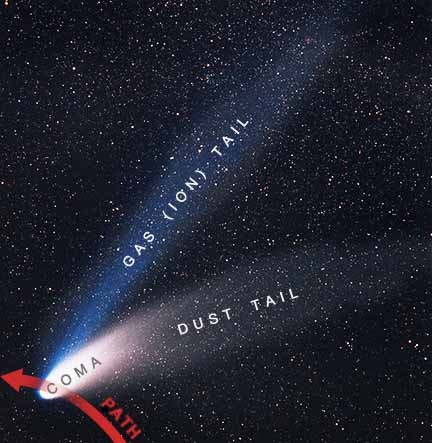
© SkyMarvels, enhancement of
original image courtesy: ESO / E. Slawik
Unmanned missions to various comets have confirmed that the gases and dust escaping their jaggedly uneven nuclei jet forth" like immense fountains, rather than uniformly as had once been believed. The escaping material then often differentiates into separate gas and dust tails. The gas tail (also called the "ion" tail) points directly away from the Sun, while the dust tail can bend noticeably away from it and give the comet the appearance of an angle sign (<).
From NASA Goddard's Scientific Visualization Studio, here's a great animation showing 14 Years of Comets Seen by SOHO. ![]() . It gives us an appreciation for just how many comets whisk through our Solar System.
. It gives us an appreciation for just how many comets whisk through our Solar System.

Comet Nucleus: © SkyMarvels, enhancement of NASA image
As comets lose a significant amount of mass during each visit to the inner Solar System, their lifetimes may only extend from 50 to a few thousand orbits. Finally, having lost most of their volatile gases, they will more resemble asteroids than their former selves.
Over 4,000 comets have been identified, this relatively small number due to the difficulty in detecting ones far from the Sun. Nonetheless, it is theorized that billions and possibly trillions of comets may exist as part of our Solar System. Less numerous "short-period" comets are thought to originate in the Kuiper Belt, while "long-period" comets are thought to originate in that "great repository of comet nuclei," the Oort Cloud.
Here are cometa Churyumov-Gerasimenko, Hartley and Borelly in NASA's Eyes on Asteroids.
MORE INTERESTING COMET LINKS
From the Adler Planetarium Explore the Aquarius Asteroid's Orbit and Impact!
From the BBC here's Rosetta: the Whole Story.
Link to a nice interactive from the New York Times: Rosetta's Philae Lander Wakes Up From Hibernation.
A nice NASA animation of Rosetta's Comet Target: 67P/Churyumov-Gerasimenko. ![]() .
.
CENTAURS
Generally speaking, a centaur is a smaller object whose orbit around the Sun is of a size (on average) between that of Jupiter and that of Neptune. (However, the Minor Planet Center (MPC), the Jet Propulsion Laboratory (JPL), and the Deep Ecliptic Survey (DES) all define centaurs slightly differently.)
Centaurs interest astronomers because they exhibit characteristics not only of asteroids but also of comets. In addition, as they cross the orbits of one or more of the gas giants, most have unstable orbits. As a family, they also display an unexplained variation of surface colors. Here are good Wikipedia graphics showing the orbital distribution of the Centaurs and the colors of the Centaurs. And here is Wikipedia's Centaur page.
KUIPER BELT OBJECTS &
TRANS-NEPTUNIAN OBJECTS
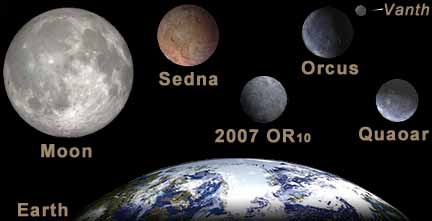
© SkyMarvels, enhancement of NASA, STSci image
Bodies composed mainly of frozen water, methane and ammonia, Kuiper Belt Objects (KBO's) orbit the Sun in a considerably larger and more distant counterpart to the Asteroid Belt. The Kuiper Belt ![]() stretches roughly from Neptune's orbit out to 50 AU from the Sun, possibly farther. NASA Kuiper Belt Poster
stretches roughly from Neptune's orbit out to 50 AU from the Sun, possibly farther. NASA Kuiper Belt Poster
In addition to constituting their own family of objects, KBO's also belong to another more general family, the Trans-Neptunian Objects (TNO's). A TNO is simply any object whose orbit around the Sun is larger on average than the orbit of Neptune. By this definition, TNO's therefore technically include all objects in the Oort Cloud. Here is a good Wikipedia graphic that clarifies the distinction between Centaurs and KBO's & TNO's while at the same time showing many smaller worlds of our Solar System.
It should be noted that, as the accepted KBO and TNO classifications depend on location instead of structure, the 4 outer dwarf planets (Pluto, Eris, Haumea and Makemake) are both KBO's and TNO's.
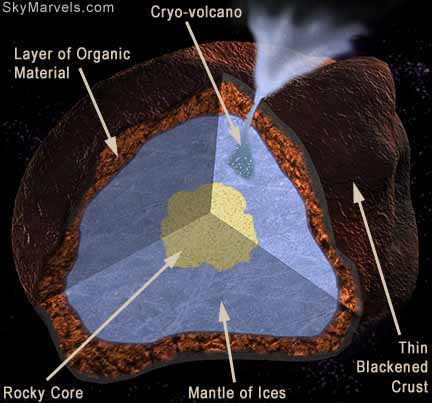 Theoretical KBO Structure: © SkyMarvels, enhancement
Theoretical KBO Structure: © SkyMarvels, enhancement
of NASA/Conceptual Image Lab/Tyler Chase image
By 2013, over a thousand KBO's had been discovered. However, because they are so distant from the Sun, and therefore difficult to detect, it is believed that there may be hundreds of thousands of KBO's that are larger than 100 kilometers in diameter! Smaller KBO's also almost certainly exist, and these are likely to be more irregular in shape.
Almost all KBO's are believed to have originated in our Solar System's protoplanetary disc, but they were too thinly scattered and too far from the developing Sun to coalesce into full-sized planets. Despite the substantial numbers that have been theorized, and the relatively large numbers of sizeable ones, KBO's are believed to have a total combined mass of only about three or four times the mass of our Moon.
MORE INTERESTING KBO & TNO LINKS
IAU List of Trans-Neptunian Objects
Wikipedia's Trans-Neptunian Object page
METEORS, METEOROIDS, METEORITES
Though "meteors", "meteoroids" and "meteorites" are three terms that are often used interchangeably, there are subtle but significant differences to their meanings.
Smaller than asteroids, meteoroids are natural rocky or metallic objects that move through space in great numbers. Though some are the result of collisions between much larger bodies (even moons and planets,) most are believed to have once been parts of asteroids or comets. These remnants spread out in immense streams that generally follow the orbits of their parent objects, and they produce yearly meteor showers when Earth moves through them as it orbits the Sun.
Here is a SkyMarvels video that highlights the Perseid Meteor Shower, which reaches its peak in early-to-middle August every year.
Here is an awesome site that shows animations of the meteoroid streams that produce our home planet's Major Meteor Showers.
Meteoroids are so numerous that they are constantly bombarding Earth. Most are between the size of a grain of fine sand and the size of a small pea, though even objects as sizeable as a large beachball are considered meteoroids rather than asteroids. On average, about 50 tons of meteoroids are "intercepted" by our planet each and every day!
When meteoroids first encounter Earth's atmosphere, they are instantly and violently heated by atmospheric friction. This often causes them to radiate visible light and sometimes even glowing trails. We call these visual spectacles "meteors", or just as commonly "shooting stars".
Meteoroids that survive their brief and buffeting "mad dashes" through the atmosphere and strike Earth are called "meteorites". While most are inconsequential, the largest of meteorites have left sobering evidence of just how catastrophic their impacts can be. Here's a clever 3-D graphic that shows the Major Meteorite Impacts between 1800 and 2010.
Here is a nice interactive map of Confirmed Meteorite Impact Craters
![]() . And here is a similar map from NASA, which provides images of the crater locations from space: Impact Craters Collection.
. And here is a similar map from NASA, which provides images of the crater locations from space: Impact Craters Collection.
A nice poster from the AMS:
Meteor Terminology High-Res PDF.
MORE INTERESTING METEOR LINKS
Meteor Crater, Arizona in 3-D: #1 #2
From ESA's Science & Technology Facilities Council and Faulkes Telescopes: Impact Calculator
Home Intro News Gallery Sky-Gifts Bonuses Tips
Learning Ctr Help Links Credits Legal Contact Us
© 2007-
by Gary M. Winter. All rights reserved.
Interested in political cartoons and humor?
Check out The HIPPLOMATS™.
SkyMarvels, Sky Marvels, SkyMarvels.com, the Solar System's SMALLER WORLDS: Dwarf Planets, Asteroids, Kuiper Belt Objects (KBO's), Comets, celestia4all, celestiaforall, CELESTIA, astronomy, space, simulations, animations, downloadable astronomy posters, stars, planets, Inner Planets, Outer Planets, Inferior Planets, Superior Planets, moons, asteroids, comets, Oort Cloud, galaxy, galaxies, Milky Way, Andromeda, globular clusters, binaries, quasars, black holes, supermassive black holes, telescope, telescopes, planetarium, software, freestuff, satellites, add-ons, addons, scripts, eclipses, Solar Eclipses, Lunar Eclipses, Solar Eclipse Finder, Lunar Eclipse Finder, mutual eclipses, transits, occultations, Solar System, CELES-TOOLS, celeSTARrium, CELX, CELX programming, Freebies, Bonuses, multiple views, atronomical unit, light year, parsec, meteors, meteor showers, Perseids, Geminids, Leonids, barycenter, time, Time Zones, tides, alignments, conjunctions, oppositions, seasons, apogees, perigees, aphelion, perihelion, Earth, Luna, Mercury, Venus, Mars, Jupiter, Galilean Moons, Io, Europa, Ganymede, Callisto, Saturn, Titan, rings, Uranus, Neptune, Triton, E-MSpectrum, electromagnetic spectrum, astronaut, equinoxes, solstices, precession, rotation, spin, inclination, tilt, Ecliptic, orbits, ellipse, parabola, hyperbola
Donate safely with: PayPal
and receive one or more
Sky-Gifts. Your support is greatly appreciated!
NOTE: you do not need a PayPal account to donate.
SKY VIEWING
SOLAR SYSTEM
THE SUN
MERCURY
VENUS
EARTH
THE MOON
MARS
JUPITER
SATURN
URANUS
NEPTUNE
SMALLER WORLDS
STELLAR OBJECTS
EXOPLANETS
DEEP-SKY OBJECTS
SCALE OF THE COSMOS
———————
SKY-FUN / SKY-GAMES
UPCOMING:
Comets:
Visible in N Hemisphere
Visible in S Hemisphere
Meteor Showers:
IMO:
Calendar
PDF
AMS:
Calendar
Major Shower Animations
LATEST
DAWN Mission Recap
"Tour of Ceres" video
"Meet Vesta" video
Near-Earth Object Info:
CNEOS Site
NEO Close Approaches
Fireball & Bolide Map
SMALLER WORLDS
FUN FACTS
Though we now call Pluto a dwarf planet, together Pluto and Charon really constitute a binary dwarf planet! It is the only one known to exist in our Solar System!
With a 76-year orbital period, Halley's Comet is classified as a "short-period" comet. Some "long-period" comets are known to have orbital periods of millions of years!
Earth passed right through the tail of Halley's Comet in 1910!
The Kuiper Belt Object now called "Eris" was originally called "Xena", nicknamed after the TV series heroine, the warrior princess who screamed, "IY-YI-YI-YI-YI !"
Scientists have concluded that much of Earth's water was brought here by comets that collided with Earth!
![]()
SMALLER WORLDS INTERACTIVES
QUICK ACCESS LIST
Note: some links are echoed elsewhere on this page and may include descriptive text.
The Sky-Live in 3-D
Asterank in 3-D
Major Meteor Showers in 3-D
Adler Planetarium's Aquari- us Asteroid Orbit & Impact!
Major Meteorite Impacts between 1800 and 2010.
ROSETTA: (in 3-D)
Where Is Rosetta? (slow to load)
67P/Churyumov-Gerasi-menko (very slow to load, but excellent 3-D)
NASA's Eyes on the Solar System in 3-D
JPL Small-Body Database Browser
Here's a nice little Comet Simulation
Interactive Service For Asteroid Models
SMALLER WORLDS ACTIVITES
MAKE PAPER MODELS OF ASTEROIDS WITH IRREGULAR SHAPES
Asteroids come in a host of sizes and—especially smaller ones—in a surprising variety of shapes! Here are clever paper paper models that let you examine such irregular shapes from all angles!
Eros Ida Itokawa
COMET ON A STICK
Simple yet effective. Make a Comet on a Stick.
MAKE PAPER MODELS OF SPACECRAFT TO SMALLER WORLDS
More clever paper models let you build a fleet of spacecraft that have visited the smaller worlds of our Solar System!
Stardust
![]()
Rosetta
![]()
Deep Impact
![]()
Hayabusa2
![]()
OSIRIS-REx
![]() slow load
slow load
New Horizons: #1 #2
ASTEROIDS


SKYMARVELS™
CELESTIA ADD-ONS
SKYMARVELS™ POSTERS
SKYMARVELS™ VIDEOS
Solar Eclipses:
Lunar Eclipses:
Moon's Occultation of Venus 2010 May 16
Moon's Occultation of Venus 2010 Sep 11
The Same Side of the Moon Always Faces Earth